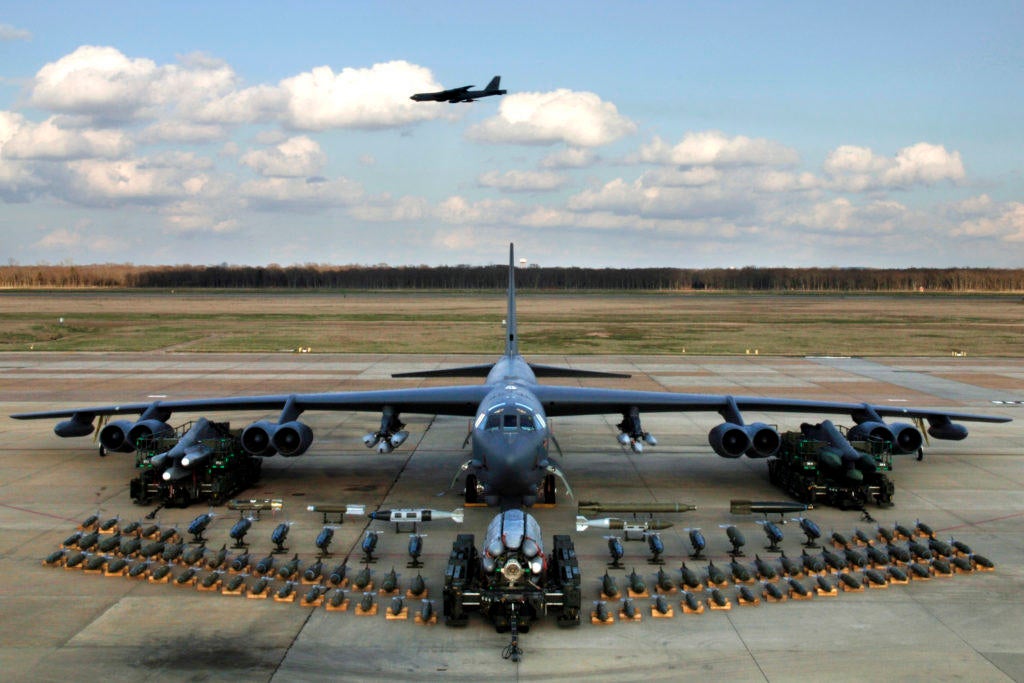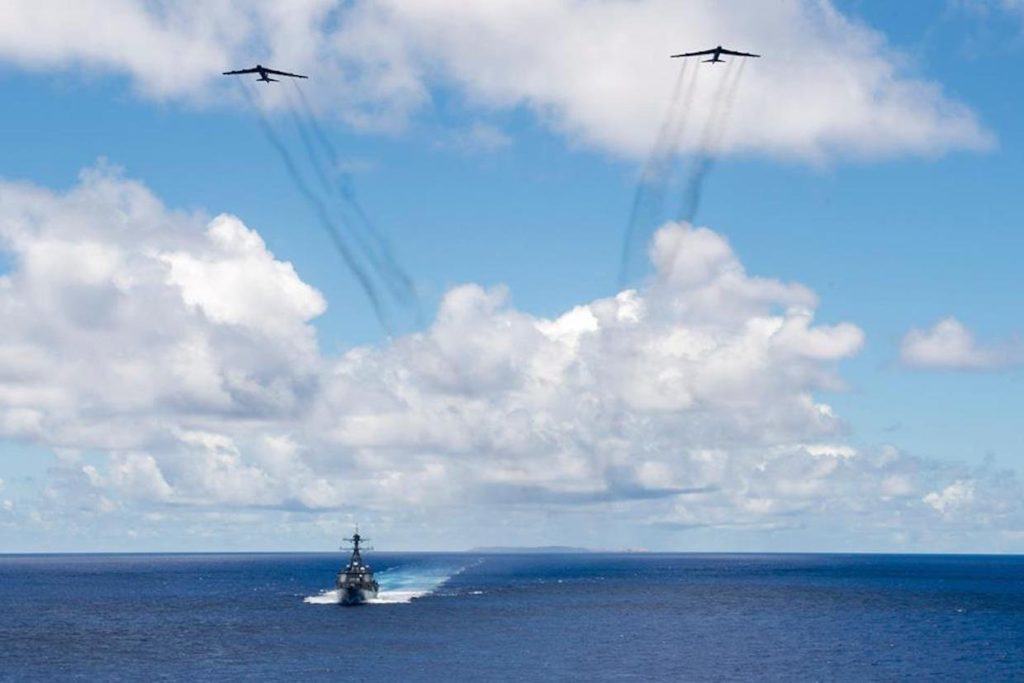The Pentagon’s emerging “Arsenal Plane” or “flying bomb truck” is likely to be a modified, high-tech adaptation of the iconic B-52 bomber designed to fire air-to-air weapons, release swarms of mini-drones and provide additional fire-power to 5th generation stealth fighters such as the F-35 and F-22, Pentagon officials and analysts said.
It is also possible that the emerging arsenal plane could be a modified C-130 or combined version of a B-52 and C-130 drawing from elements of each, Pentagon officials said.
Using a B-52, which is already being modernized with new radios and an expanded internal weapons bay, would provide an existing “militarized” platform already engineered with electronic warfare ability and countermeasures designed to thwart enemy air defenses.
“You are using a jet that already has a military capability. The B-52 is a military asset, whereas all the alternatives would have to be created. It has already been weaponized and has less of a radar cross-section compared to a large Air Force cargo plane. It is not a penetrating bomber, but it does have some kind of jamming and countermeasures meant to cope with enemy air defenses. It is wired for a combat mission,” said Richard Aboulafia, Vice President of analysis at the Teal Group, a Virginia-based consultancy.
Flying as a large, non-stealthy bomber airplane, a B-52 would still present a large target to potential adversaries; however, Defense Secretary Ashton Carter said part of the rationale for the “Arsenal Plane” would be to work closely with stealthy fighter jets such as an F-22 and F-35, with increased networking technology designed to increase their firepower and weapons load.
An “Arsenal Plane” networked to F-22 and F-35 stealth fighters would enable the fighter aircraft to maintain their stealth properties while still having substantial offensive bombing capability. If stealth fighters attach weapons to their external pylons, they change their radar signature and therefore become more vulnerable to enemy air defenses. If networked to a large “flying bomb truck,” they could use stealth capability to defeat enemy air defenses and still have an ability to drop large amounts of bombs on targets.
Such a scenario could also likely rely upon now-in-development manned-unmanned teaming wherein emerging algorithms and computer technology enable fighter jets to control the sensor payload and weapons capability of nearby drones from the cockpit of the aircraft. This would enable Intelligence, Surveillance and Reconnaissance assets to more quickly relay strategic or targeting information between fighter jets, drones and “Arsenal Planes.”

Aboulafia explained that air fighters being developed by potential adversaries, such as the Chinese J-20 and other fighters, could exist in larger numbers than a US force, underscoring the current US strategy to maintain a technological edge even if their conventional forces are smaller. An “Arsenal Plane” could extend range and lethality for US fighters, in the event they were facing an enemy force with more sheer numbers of assets.
“There is a concern about numbers of potential enemies and range. When you are dealing with a potential adversary with thousands of jets and you’ve got limited assets with limited weapons payloads, you have got to be concerned about the numbers,” he said.
An effort to be more high-tech, if smaller in terms of sheer numbers, than rival militaries is a key part of the current Pentagon force modernization strategy.
“In practice, the “Arsenal Plane” will function as a very large airborne magazine, networked to fifth generation aircraft that act as forward sensor and targeting nodes, essentially combining different systems already in our inventory to create wholly new capabilities,” Carter told reporters. Aboulafia added that an idea for an “Arsenal Plane” emerged in the 1980s as a Cold War strategy designed to have large jets carry missiles able to attack Soviet targets.
Carter unveiled the “Arsenal Plane” concept during a recent 2017 budget drop discussion at the Pentagon wherein he, for the first time, revealed the existence of a “Strategic Capabilities Office” aimed at connecting and leveraging emerging weapons and technology with existing platforms. This effort is aimed at saving money, increasing the military’s high-tech lethality and bringing new assets to the force faster than the many years it would take to engineer entirely new technologies.
“I created the SCO (Strategic Capabilities Office) in 2012, when I was Deputy Secretary of defense to help us to re-imagine existing DOD and intelligence community and commercial systems by giving them new roles and game-changing capabilities to confound potential enemies — the emphasis here was on rapidity of fielding, not 10 and 15-year programs,” he said.
Carter said “Arsenal Plane” development would be funded through a $71 billion research and development 2017 budget request.
While Carter did not specify a B-52 during his public discussion of the new asset now in-development, he did say it would likely be an “older” aircraft designed to function as a “flying launchpad.”
“The last project I want to highlight is one that we’re calling the “Arsenal Plane,” which takes one of our oldest aircraft platforms and turns it into a flying launchpad for all sorts of different conventional payloads,” Carter added.
The Air Force is already surging forward with a massive, fleet-wide modernization overhaul of the battle-tested, Vietnam-era B-52 bomber, an iconic airborne workhorse for the US military dating back to the 1960s.
Engineers are now equipping all 76 of the Air Force B-52s with digital data-links, moving-map displays, next-generation avionics, new radios and an ability to both carry more weapons internally and integrate new, high-tech weapons as they emerge, service officials said.
The technical structure and durability of the B-52 airframes in the Air Force fleet are described as extremely robust and able to keep flying well into the 2040s and beyond – so the service is taking steps to ensure the platform stays viable by receiving the most current and effective avionics, weapons and technologies.

Weapons Upgrade
Contents
Aboulafia said the new B-52 “Arsenal Plane” could, for the first time, configure a primarily air-to-ground bomber as a platform able to fire air-to-air weapons as well – such as the Advanced Medium Range Air to Air Missile, or AMRAAM.
The integration of air-to-air weapons on the B-52 does not seem inconceivable given the weapons upgrades already underway with the aircraft. Air Force is also making progress with a technology-inspired effort to increase the weapons payload for the workhorse bomber, Eric Single, Chief of the Global Strike Division, Acquisition, told Scout Warrior in an interview several months ago.
The 1760 Internal Weapons Bay Upgrade, or IWBU, will allow the B-52 to internally carry up to eight of the newest “J-Series” bombs in addition to carrying six on pylons under each wing, he explained.
B-52s have previously been able to carry JDAM weapons externally, but with the IWBU the aircraft will be able to internally house some of the most cutting edge precision-guided Joint Direct Attack Munitions and Joint Air-to-Surface Standoff Missiles, among others.
“It is about a 66 percent increase in carriage capability for the B-52, which is huge. You can imagine the increased number of targets you can reach, and you can strike the same number of targets with significantly less sorties,” said Single.
Single also added that having an increased internal weapons bay capability affords an opportunity to increase fuel-efficiency by removing bombs from beneath the wings and reducing drag.
The first increment of IWBU, slated to be finished by 2017, will integrate an internal weapons bay ability to fire a laser-guided JDAM. A second increment, to finish by 2022, will integrate more modern or cutting-edge weapons such as the Joint Air-to-Surface Standoff Missile, or JASSM, JASSM Extended Range (ER) and a technology called Miniature Air Launched Decoy, or MALD. A MALD-J “jammer” variant, which will also be integrated into the B-52, can be used to jam enemy radar technologies as well, Single said.
IWBU, which uses a digital interface and a rotary launcher to increase the weapons payload, is expected to cost roughly $313 million, service officials said.
The B-52 has a massive, 185-foot wingspan, a weight of about 185,000 pounds and an ability to reach high sub-sonic speeds and altitudes of 50,000 feet, Air Force officials said.

Communications, Avionics Upgrades
Two distinct, yet interwoven B-52 modernization efforts will increase the electronics, communications technology, computing and avionics available in the cockpit while simultaneously configuring the aircraft with the ability to carry up to eight of the newest “J-Series” precision-guided weapons internally – in addition to carrying six weapons on each wing, Single said.
Eight B-52s have already received a communications (coms systems) upgrade called Combat Network Communication Technology, or CONECT – a radio, electronics and data-link upgrade which, among other things, allows aircraft crews to transfer mission and targeting data directly to aircraft systems while in flight (machine to machine), Single explained.
“It installs a digital architecture in the airplane,” Single explained. “Instead of using data that was captured during the mission planning phase prior to your take off 15 to 20 hours ago – you are getting near real-time intelligence updates in flight.”
Single described it key attribute in terms of “machine-to-machine” data-transfer technology which allows for more efficient, seamless and rapid communication of combat-relevant information.
Using what’s called an ARC 210 Warrior software-programmable voice and data radio, pilots can now send and receive targeting data, mapping information or intelligence with ground stations, command centers and other aircraft.
“The crew gets the ability to communicate digitally outside the airplane which enables you to import not just voice but data for mission changes, threat notifications, targeting….all those different types of things you would need to get,” Single said.
An ability to receive real-time targeting updates is of great relevance to the B-52s close-air-support mission because fluid, fast-moving or dynamic combat situations often mean ground targets appear, change or disappear quickly.
Alongside moving much of the avionics from analogue to digital technology, CONECT also integrates new servers, modems, colored display screens in place of old green monochrome and provides pilots with digital moving-map displays which can be populated with real-time threat and mission data, Single said.
The new digital screens also show colored graphics highlighting the aircraft’s flight path, he added.
Single explained that being able to update key combat-relevant information while in transit will substantially help the aircraft more effectively travel longer distances for missions, as needed.
“The key to this is that this is part of the long-range strike family of systems — so if you take off out of Barksdale Air Force Base and you go to your target area, it could take 15 or 16 hours to get there. By the time you get there, all the threat information has changed,” said Single. “Things move, pop up or go away and the targeting data may be different.”
The upgrades will also improve the ability of the airplane to receive key intelligence information through a data link called the Intelligence Broadcast Receiver. In addition, the B-52s will be able to receive information through a LINK-16-like high-speed digital data link able to transmit targeting and Intelligence, Surveillance and Reconnaissance, or ISR information.
The CONECT effort, slated to cost $1.1 billion overall, will continue to unfold over the next several years, Single explained.
Twelve B-52 will be operational with CONECT by the end of this year and the entire fleet will be ready by 2021, Single said.
B-52 History
Known for massive bombing missions during the Vietnam War, the 159-foot long B-52s have in recent years been operating over Afghanistan in support of military actions there from a base in Guam.
The B-52 also served in Operation Desert Storm, Air Force statements said. “B-52s struck wide-area troop concentrations, fixed installations and bunkers, and decimated the morale of Iraq’s Republican Guard,” an Air Force statement said.
In 2001, the B-52 provided close-air support to forces in Afghanistan during Operation Enduring Freedom, service officials said. The B-52 also played a role in Operation Iraqi Freedom. On March 21, 2003, B-52Hs launched approximately 100 CALCMs (Conventional Air Launched Cruise Missiles) during a night mission.
Given the B-52s historic role in precision-bombing and close air support, next-generation avionics and technologies are expected to greatly increase potential missions for the platform in coming years, service officials said.
WATCH: B-52s are blasting ISIS targets


